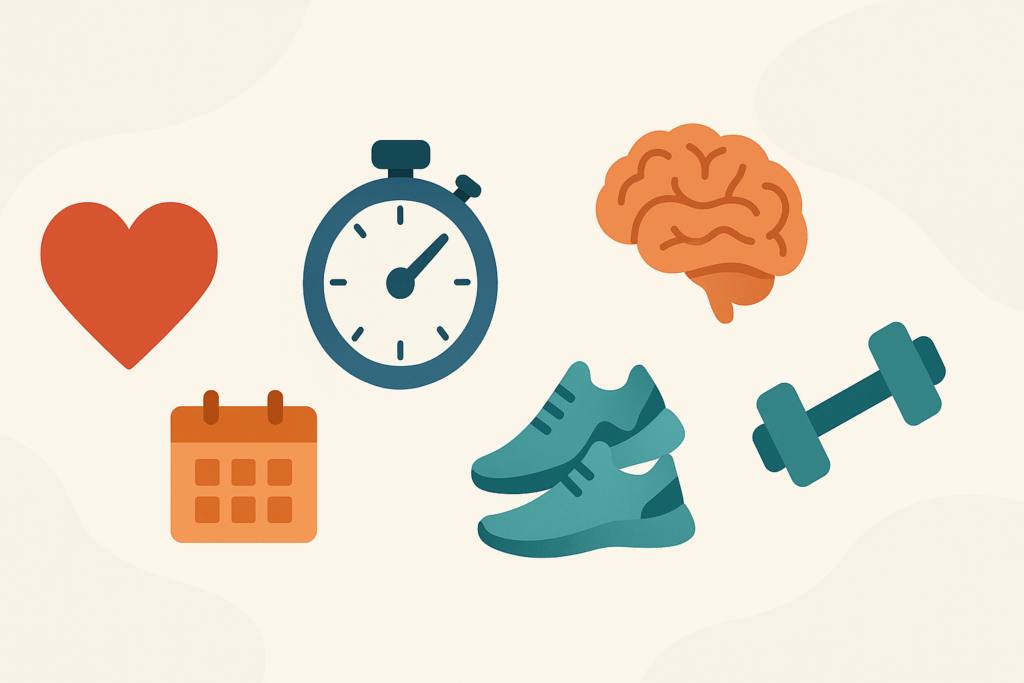Introduction: Why Cardiovascular Training Matters More Than Ever
In an age when daily schedules are overflowing with responsibilities, the pursuit of optimal health and performance can often take a back seat. However, science continues to reinforce the importance of cardiovascular training not only for heart health but also for mental clarity, stamina, and long-term physical performance. For individuals looking to improve endurance naturally, the idea of dedicating just a few minutes per day to cardiovascular exercise offers a compelling, achievable solution. In fact, modern research challenges the outdated notion that extended workout sessions are the only path to meaningful fitness results. Instead, it shows that well-structured cardiovascular exercise recommendations, even in limited time frames, can foster powerful transformations in stamina, mood, and metabolic efficiency.
You may also like: How to Increase Stamina and Endurance Naturally: Smart Training Tips and Nutrition Habits That Support Cardiovascular Fitness
Endurance and stamina are not merely the concern of athletes; they affect everything from how easily one can climb a flight of stairs to how mentally alert and emotionally stable one feels throughout the day. These outcomes depend largely on cardiovascular conditioning—how efficiently the heart, lungs, and blood vessels transport oxygen and nutrients to working muscles. Even committing to cardiovascular training for just a few minutes per day can initiate significant physiological improvements, including enhanced aerobic capacity, better glucose regulation, and a lower resting heart rate. The key lies not in the duration alone but in the consistency and quality of effort put forth.
Moreover, the shift toward natural performance enhancement strategies, as opposed to synthetic aids or excessive supplementation, aligns with current public health trends advocating for sustainability, accessibility, and long-term adherence. Embracing simple, evidence-based cardiovascular exercise recommendations allows individuals to enhance endurance without the need for elaborate equipment or expensive gym memberships. As we explore these expert insights, it becomes increasingly evident that the path to peak performance may start with a simple, consistent routine that only takes minutes per day.

Understanding Cardiovascular Fitness and Its Impact on Human Performance
Cardiovascular fitness represents the foundation upon which all other aspects of physical health are built. It refers to the ability of the cardiovascular system to supply oxygen-rich blood to the muscles during sustained physical activity. The benefits of strong cardiovascular health extend far beyond endurance alone. From reducing the risk of chronic diseases such as hypertension and type 2 diabetes to enhancing cognitive function and immune resilience, cardiovascular conditioning plays a pivotal role in both health maintenance and performance enhancement.
Scientific studies have consistently demonstrated that improving cardiovascular capacity leads to a more efficient circulatory system, which helps deliver nutrients faster and remove metabolic waste more effectively. This efficiency not only allows for extended physical effort but also accelerates recovery. For individuals engaged in endurance and stamina training, this means being able to train more frequently without compromising performance or risking injury. Even brief but consistent bouts of cardiovascular activity—performed for as little as ten minutes per day—can elicit measurable improvements in VO2 max, the standard metric for assessing aerobic fitness.
A common misconception is that endurance gains require marathon-length training sessions. However, research in exercise physiology has shown that even high-intensity interval training (HIIT), performed in sessions as short as four to seven minutes per day, can stimulate mitochondrial growth in muscles and increase cardiovascular output. These adaptations are critical for endurance athletes but also highly relevant to the general population aiming to feel more energetic throughout their daily routines. In this context, expert-driven cardiovascular exercise recommendations are not about pushing the limits of time but about optimizing the return on every minute invested.

The Science Behind Minutes Per Day: How Little Effort Can Yield Big Gains
One of the most revolutionary insights in recent sports science is the realization that cardiovascular benefits can be accrued in surprisingly short timeframes. The concept of training for only a few minutes per day may initially seem counterintuitive, especially in a culture where longer often equates to better. Yet, a growing body of research now supports the claim that quality can often outweigh quantity when it comes to cardiovascular conditioning.
Studies from institutions such as McMaster University and the American College of Sports Medicine reveal that high-intensity efforts—even those lasting under ten minutes—can produce physiological responses equivalent to those elicited by traditional moderate-intensity sessions lasting forty-five minutes or more. The key lies in strategic structuring: incorporating alternating periods of high and low effort maximizes both aerobic and anaerobic system activation. When applied consistently, such protocols not only improve cardiovascular markers but also support hormonal balance, mental focus, and fat oxidation.
It’s important to emphasize that even steady-state cardiovascular exercise, performed at moderate intensity for a minimum of ten minutes per day, has been shown to reduce resting blood pressure and improve insulin sensitivity. The phrase “minutes per day” may sound modest, but it encapsulates a vital strategy for those juggling busy schedules and seeking to make meaningful health improvements. From brisk walking to stair climbing, the nature of the activity matters less than the intent and effort behind it.
The idea is not to eliminate long workouts but to reframe our understanding of what constitutes effective exercise. Incorporating cardiovascular activity for a few min per day can be a gateway to a more active lifestyle and a foundation for improved endurance, performance, and resilience. By grounding these efforts in credible cardiovascular exercise recommendations, individuals can make the most of even the smallest time investments.

Natural Performance Enhancement Through Consistent Cardio Habits
The pursuit of natural performance enhancement is rooted in lifestyle choices that favor sustainability, health, and long-term adaptability. Cardiovascular exercise, when practiced consistently—even if only for a few minutes per day—serves as one of the most potent tools in this pursuit. Beyond boosting aerobic capacity, regular cardiovascular activity triggers hormonal responses that enhance focus, mood stability, and sleep quality. These cumulative effects can significantly enhance not only physical but also cognitive and emotional performance.
For individuals seeking to improve endurance naturally, the secret often lies in developing habits rather than executing sporadic, high-volume workouts. The consistency of movement—whether through morning jogs, lunchtime walks, or short evening bike rides—leads to physiological adaptations over time. Improved mitochondrial density, increased capillarization in muscle tissue, and elevated red blood cell count are just some of the adaptations that contribute to enhanced oxygen delivery and usage. These processes lay the groundwork for increased stamina, even in individuals starting with a minimal fitness base.
Integrating cardiovascular activity into daily routines doesn’t necessarily require structured sessions. Even non-exercise physical activity, such as gardening, playing with children, or taking the stairs instead of the elevator, contributes to cardiovascular fitness. When these moments are strategically accumulated, they reflect the core principle behind expert cardiovascular exercise recommendations: consistency trumps volume. The message is clear—natural endurance gains are accessible to anyone willing to engage intentionally, even if only for a few min per day.

Designing an Effective Short-Duration Cardio Plan for Maximum Endurance Gains
Constructing a cardio regimen that maximizes endurance gains without demanding excessive time requires thoughtful planning and a basic understanding of physiological thresholds. The key is to blend intensity and variety while adhering to the principle of progression. For those working with limited availability, the focus should be on exercises that elevate heart rate quickly and sustain it within the target zone. This often includes activities such as jump rope, cycling sprints, hill climbs, or bodyweight circuits that involve multiple muscle groups.
The foundational principle in most cardiovascular exercise recommendations is the overload principle—gradually increasing the intensity or duration of activity to elicit continual adaptation. When time is limited, intensity becomes the primary lever. For example, a well-executed 7-minute HIIT session involving 30-second intervals of sprinting, jumping jacks, or mountain climbers followed by short recovery periods can provide sufficient stimulus to challenge the cardiovascular system and encourage endurance improvements.
It is also essential to track progress over time, even with short sessions. Simple metrics such as heart rate variability, perceived exertion, or how quickly the heart rate recovers post-exercise can provide meaningful insights into cardiovascular adaptation. Incorporating rest days and active recovery—such as yoga, stretching, or leisurely walks—is crucial to prevent burnout and ensure consistent improvement.
A good plan will also consider the individual’s current fitness level, age, and any pre-existing health conditions. By aligning with professional cardiovascular exercise recommendations and tailoring the approach to personal needs, it becomes entirely feasible to boost endurance and performance with just minutes per day.

Overcoming Common Barriers to Consistent Cardiovascular Training
Despite the well-documented benefits, many individuals struggle to maintain regular cardiovascular exercise routines. The most frequently cited barriers include lack of time, motivation, and uncertainty about where to start. However, reframing the concept of effective training as something achievable in just a few min per day can drastically reduce these psychological and logistical roadblocks. This shift makes physical activity seem less daunting and more compatible with modern life.
Addressing the time barrier begins with a mindset shift. Instead of viewing fitness as a rigid task requiring an hour-long commitment, consider it a fluid opportunity to inject brief bursts of movement throughout the day. Whether it’s ten minutes of jumping rope in the morning, a brisk walk during lunch, or a short cycle session in the evening, these moments add up and collectively contribute to endurance gains. Such flexibility is at the core of expert-backed cardiovascular exercise recommendations.
Motivational hurdles can be overcome by establishing clear goals, tracking progress, and cultivating enjoyment. Choosing activities that feel rewarding—whether dancing, trail walking, or swimming—can foster intrinsic motivation. Creating a ritual around your min per day sessions also builds consistency. Even listening to an engaging podcast or favorite music playlist can turn a routine cardio burst into a moment of daily joy.
For beginners, knowledge gaps often serve as a deterrent. This can be addressed through educational resources, fitness apps, or consultations with certified trainers. Clarifying the safety and structure of cardiovascular routines is part of making these habits stick. When individuals feel informed and supported, they are more likely to stay committed—even when only carving out a few minutes per day.
Frequently Asked Questions (FAQ): Expert Insights on Cardiovascular Training and Endurance
What is the best way to stay motivated when only exercising for a few minutes per day?
Staying motivated when working out for just a few minutes per day hinges on redefining what success looks like. One helpful strategy is to pair these short bursts of cardiovascular exercise with habit-stacking techniques—for example, doing your workout right after brushing your teeth or while waiting for your morning coffee to brew. This helps create a seamless integration of movement into your routine, making it easier to stay consistent. Keeping a visible log of your progress, such as a journal or digital tracker, reinforces the psychological satisfaction of small wins. Many people find that knowing they only need to commit a few min per day removes the dread of long workouts and actually makes them more likely to maintain a long-term habit.
Can short cardio sessions throughout the day be as effective as one longer session?
Yes, accumulating cardiovascular activity in short, spread-out intervals can offer similar health benefits to one continuous session. This approach—sometimes called “exercise snacks”—can stimulate metabolism, increase heart rate variability, and promote sustained energy levels throughout the day. Following expert cardiovascular exercise recommendations, such sessions should still reach a moderate to vigorous intensity to yield optimal benefits. For example, three 5-minute walks after meals may help improve glycemic control and circulation just as effectively as a 15-minute continuous walk. This flexibility encourages adherence and makes meeting the “minutes per day” goal more realistic for those with unpredictable schedules.
What are the most efficient types of cardio for building endurance in limited time?
When time is limited, choosing exercises that offer the greatest physiological return is essential. Compound movements such as jump squats, burpees, or cycling sprints engage multiple muscle groups and elevate the heart rate rapidly, maximizing cardiovascular demand. For individuals following targeted cardiovascular exercise recommendations, interval formats—such as Tabata or EMOM (every minute on the minute)—are ideal for squeezing maximum intensity into just a few min per day. These methods also support endurance gains by pushing the body to adapt to both anaerobic and aerobic stressors. Efficiency in cardio is not just about how hard you work but how strategically you structure that effort.
How does consistent cardio benefit mental clarity and cognitive performance?
Cardiovascular training doesn’t just elevate your heart rate—it elevates your mind. Regular cardio, even when done for a few minutes per day, has been shown to increase blood flow to the brain, improving executive function, memory retention, and creative thinking. These benefits are linked to increased production of neurotrophic factors such as BDNF (Brain-Derived Neurotrophic Factor), which supports neuroplasticity. Some workplace wellness programs are now incorporating short bursts of cardio based on cardiovascular exercise recommendations to help employees re-engage with tasks after periods of fatigue or distraction. This underscores that improving endurance isn’t only about physical stamina—it’s also about sharpening mental focus.
Are there age-specific considerations when following cardiovascular exercise recommendations?
Absolutely. While cardiovascular fitness is essential across all ages, the approach should be tailored to the individual’s phase of life. For younger adults, high-intensity interval work may be safe and highly effective, even in short durations. For older adults or those with preexisting health concerns, steady-state cardio for 10–15 minutes per day may be more appropriate and sustainable. Nonetheless, integrating cardiovascular exercise recommendations into everyday life—regardless of age—can lead to improved mobility, better metabolic control, and reduced risk of cognitive decline. Even a few carefully selected minutes per day can provide immense long-term value when the routine is adapted to individual needs.
Can you still lose weight or improve body composition with only a few minutes of cardio each day?
Yes, but success depends on intensity, consistency, and complementary lifestyle factors like nutrition and sleep. High-effort workouts done for a few minutes per day can significantly impact metabolic rate and fat oxidation, particularly when paired with strength training or fasting protocols. Cardiovascular exercise recommendations often emphasize that while calorie burn may be modest in short sessions, the cumulative hormonal and metabolic effects can be powerful. Over time, these small but regular efforts can lead to measurable changes in body composition, especially when they become part of a broader wellness strategy. The key is persistence—not perfection.
What role does breathing technique play in short-duration cardio?
Breathing is often overlooked in cardio, yet it’s a critical factor in endurance training, especially when time is limited. Practicing diaphragmatic breathing helps improve oxygen efficiency and reduces premature fatigue, allowing you to push harder during even brief workouts. Some cardiovascular exercise recommendations now include breath-control techniques inspired by practices like yoga or performance breathing to improve focus and recovery. When you only have a few min per day to train, every breath counts—literally. Training the breath alongside the body enhances performance by aligning respiratory and muscular efficiency.
How can I measure progress when doing just a few minutes of cardio per day?
Tracking progress from short workouts requires a shift from volume-based thinking to performance-based indicators. Improvements in heart rate recovery, perceived exertion, or increased repetitions within the same timeframe are strong signals of progress. Many smartwatches and fitness apps offer insights aligned with cardiovascular exercise recommendations, helping users monitor endurance, VO2 max trends, and stress levels. You might notice that after several weeks of consistent effort, those few min per day feel easier, and you recover faster. These subtle shifts are signs that your cardiovascular system is becoming more efficient—even if the total time spent exercising remains minimal.
Is fasted cardio effective if performed for only a few minutes?
Fasted cardio, typically done in the morning before breakfast, can still stimulate fat utilization even when performed for a short duration. While longer fasted workouts may amplify these effects, a few minutes per day of moderate to high-intensity cardio in a fasted state may help improve metabolic flexibility. However, it’s essential to consider your personal energy levels and avoid excessive intensity without proper fuel. For those following evidence-based cardiovascular exercise recommendations, fasted cardio may serve as a tool for fat adaptation rather than a primary weight-loss strategy. Used strategically, it can support endurance development while enhancing metabolic health.
What emerging trends could reshape the way we approach short-duration cardio training?
One of the most promising trends is the integration of virtual reality and immersive tech into cardiovascular routines. These tools turn short workouts into interactive experiences, making it easier to commit to those precious minutes per day. Another innovation includes AI-driven fitness coaching, which offers personalized cardiovascular exercise recommendations based on real-time biofeedback and lifestyle data. As more research supports the effectiveness of minimal-duration training, we’re also seeing fitness brands develop micro-workout platforms focused on delivering results in under 10 minutes. These advancements reflect a cultural shift: performance and endurance are no longer reserved for those with hours to spare but are now accessible to anyone willing to invest just a few focused min per day.
Conclusion: Small Steps, Stronger Body—Why Minutes Per Day Can Redefine Your Performance Potential
In a world that often glorifies extremes, the idea that sustainable performance enhancement can stem from small, consistent actions offers both relief and empowerment. Cardiovascular exercise recommendations from leading experts and institutions have made it clear that quality and consistency matter more than sheer volume. Engaging in purposeful cardiovascular training, even for just a few minutes per day, lays the foundation for transformative improvements in endurance, stamina, and overall vitality.
When we shift our mindset from “more is better” to “better is enough,” we allow ourselves the flexibility to thrive within our existing lifestyles. Natural performance enhancement becomes not a distant goal but a practical reality. Whether your aim is to complete a 10K run, keep up with your kids, or simply feel more energized at work, incorporating brief, strategic cardio sessions can help get you there. This is not a shortcut—it is a smarter route grounded in evidence-based practice.
Ultimately, boosting endurance naturally does not require an overhaul of your daily schedule. It requires intention, consistency, and trust in the process. By dedicating just a few focused minutes per day to cardiovascular training and following expert-approved recommendations, you are investing in a healthier, more resilient version of yourself. And that investment, minute by minute, could be the most rewarding one you ever make.
Was this article helpful? Don’t let it stop with you. Share it right now with someone who needs to see it—whether it’s a friend, a colleague, or your whole network. And if staying ahead on this topic matters to you, subscribe to this publication for the most up-to-date information. You’ll get the latest insights delivered straight to you—no searching, no missing out.

